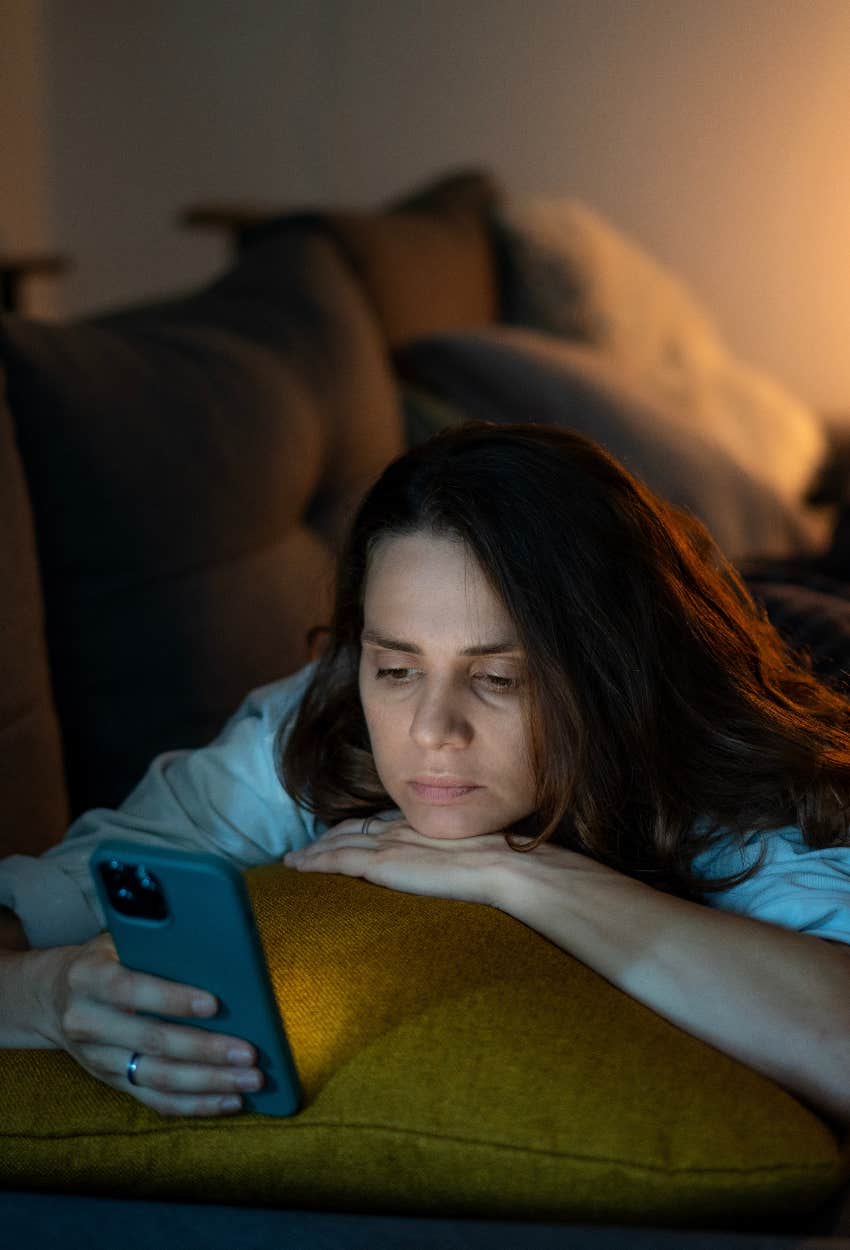This Simple 3-Step Test Reveals If Your Screen Time Has Gotten A Little Out Of Control
It all comes down to three Fs.
 MAYA LAB | Shutterstock
MAYA LAB | Shutterstock We all know the dangers of too much screen time by now — disrupted sleep, increased depression and anxiety, and an attention span that is basically non-existent, to name a few. But how do you know what exactly constitutes "too much" screen time? One expert has an answer that might help demystify this all.
A simple 3-step test helps determine if your screen time is too high.
According to recent research, people spend an average of six hours and 40 minutes a day on screens, well above the usual guidelines of two hours per day at most. If you're like most people, two hours a day sounds absolutely absurd. So many of us log at least double that just at work alone, to say nothing of our recreational hours.
 Kaboompics.com | Pexels
Kaboompics.com | Pexels
Plus, some of those screen time hours are actually keeping us productive, right? It's not like we can go back to doing our jobs with abacuses and stone tablets. Faye Hwang, an executive at gaming platform LDShop, believes these guidelines miss the mark entirely for nearly all of us.
"The old '2 hours maximum' advice doesn't reflect how we actually live and work today," she said. “Instead of focusing solely on time, we need to look at what our screen use is actually doing for us and to us."
She explained that a better approach takes into account what all that screen time is being used for, not the amount of time itself. "Are they learning a new skill, connecting with friends, or getting work done?" Hwang asked. "Or are they mindlessly scrolling through content that leaves them feeling worse? The activity matters more than the timer.”
Hwang's "3 Fs" approach considers not the time, but the purpose and impacts of screen time. This method helps us determine whether our screen time is helping or harming us. It all comes down to three questions.
1. Function: Is the screen time productive?
This question examines whether your digital activity serves some kind of goal. Is it a work presentation or online course, or just a video call with family or a gaming session? It's not about whether the accomplishment is something serious, but rather about the intention behind it.
Hwang took gaming as an example: It's easy to feel guilty about "wasted" time, but if it's something you enjoy doing that helps you blow off steam, connect to online friends, or stoke your creativity, that's all beneficial. "Compare that to someone who opens social media with no particular goal and finds themselves still scrolling an hour later," Hwang said. That's just a mindless time suck that is likely to leave you feeling worse.
 Olezzo | Shutterstock
Olezzo | Shutterstock
2. Focus: Are you engaged, or are you multitasking, zoning out, or doomscrolling?
"Quality of attention during screen use reveals a lot about its value," Hwang said. Obviously, mindless doomscrolling on the couch and researching a new hobby are two completely different things. Even things like gaming or watching comedy videos on TikTok can be edifying if they help you unwind and enjoy yourself.
The difference is that you're present during that kind of screen use. Hwang said having multiple apps open simultaneously, checking your phone while watching TV, and especially feeling like time "disappeared" without accomplishing anything meaningful are all tell-tale signs that the "function" of your screen time is not beneficial.
3. Fatigue: Does your screen time leave you feeling drained, anxious, or irritable?
Catching up with friends, watching nature videos, or using social media to research an upcoming trip of a lifetime — those all leave you feeling positive, most likely, and as though you've accomplished something, even if it's just having enjoyed your free time.
Doomscrolling, on the other hand — or any kind of mindless scrolling for that matter — tends to do the opposite. "Pay attention to how you feel when you step away from the screen,” advised Hwang. “If you're rubbing your eyes, feeling agitated, or experiencing that 'digital hangover' sensation, your body is giving you important feedback.”
 Mahir KART |Shutterstock
Mahir KART |Shutterstock
If 2 out of 3 Fs are negative, it's time to cut back and do these three things instead:
If your answers to two out of the three Fs are negative, it's time to re-evaluate your screen time usage. Hwang shared three practices that can help you recalibrate and develop better habits.
1. Create transition rituals.
Hwang recommended building in "buffers" between tasks. So if you're going from answering work emails to vegging out on social media, take a couple of minutes to stretch or grab a glass of water first. "This helps your brain reset and makes you more intentional about the next activity," she said.
2. Use the 20-20-20 rule.
Every 20 minutes, look at something 20 feet away for 20 seconds. Hwang recommended adding a step: using these breaks to check in with yourself about whether your current screen activity is helpful or harmful. This will help curtail mindless scrolling.
3. Batch activities.
Give yourself blocks of time each day that are designated for checking notifications, using social media, reviewing news, or gaming. This keeps any one of these from taking over your day, avoids doomscrolling, and helps stave off so-called "digital fatigue."
John Sundholm is a writer, editor, and video personality with 20 years of experience in media and entertainment. He covers culture, mental health, and human interest topics.

